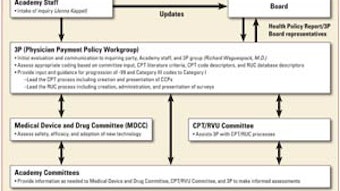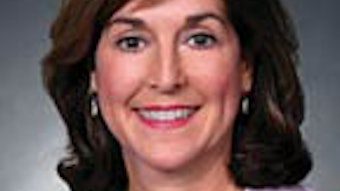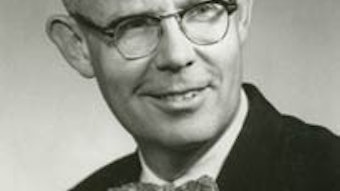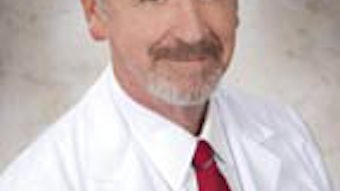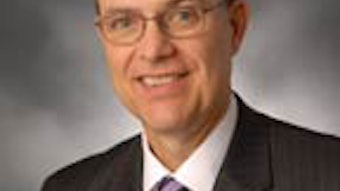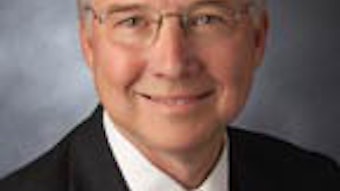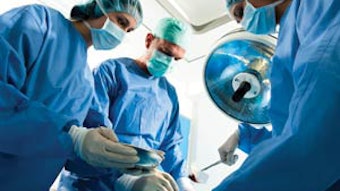Instruction Courses for the 2012 Annual Meeting
This begins a Bulletin series of instruction courses samplers each month from the myriad options to be offered at the 2012 AAO-HNSF Annual Meeting & OTO EXPO in September. One notable course in each of the nine categories will be listed with an excerpt from its objective each month. To read the full course description and to get your first choice of courses, sign up early. The series is based on selections made by Eduardo M. Diaz, Jr., MD, coordinator for instruction courses. Make sure to take advantage of the scheduler to review the full listing of courses and to enable you to find those of special interest to you. Business of Medicine/Practice Management 2729-2 Business of Medicine for Residents and Fellows Interactive Lee D. Eisenberg, MD, MPH 3:00 pm-5:00 pm, September 10 Residents and fellows often do not give adequate consideration to where they wish to practice: family considerations, lifestyle, and community. In addition, the interview process and contract issues are frequently neglected. A discussion of the CPT process, how new codes are added and valued, and E&M coding documentation, modifiers and their appropriate usage will complete the course. Facial Plastic and Reconstructive Surgery 3524-1 Botox and Fillers for Facial Lines and Wrinkles Andrew Blitzer, MD 12:30 pm-1:30 pm, September 11 This course will focus on minimally invasive techniques for facial rejuvenation. All of the available autologous, heterologous, and alloplastic materials will be reviewed. The mechanisms of action, indications, and contraindications of botulinum toxin use for facial lines will be reviewed. The technique of botulinum toxin injections for upper face, midface, and lower face and neck, and the complications will be reviewed. The combination use of injectable fillers, botulinum toxin, and/or laser resurfacing will also be reviewed. General Otolaryngology 3723-2 Histology, Histopathology, and Radiology of the Ear Sujana S. Chandrasekhar, MD 3:00 pm-5:00 pm, September 11 By correlating CT imaging of the temporal bone with its histologic anatomy, and then correlating diseases of the ear with the attendant histopathology, this course will enable the student to have a more thorough understanding of the complex anatomy and physiology, and leave him/her with an increased ability to perform otologic diagnosis and surgery with enhanced patient safety. Head and Neck Surgery 4716-1 The HPV Epidemic and Oropharyngeal Cancer James William Rocco, MD 2:30 pm-3:30 pm, September 9 Head and neck cancer in the United States and the Western world is undergoing a major shift in epidemiology. A dramatic increase in oropharyngeal cancer due to an ongoing epidemic of HPV infection is occurring in a large cohort of patients without the traditional risk factors of tobacco and alcohol abuse. This course will review the clinical implications of this HPV oropharyngeal epidemic for the general otolaryngologist. Laryngology/Broncho-Esophagology 3620-1 Building a Busy Laryngology Practice Albert L. Merati, MD 1:45 pm-2:45 pm, September 11 Laryngology continues to be a major growth area within Otolaryngology. Two clinicians with a combined 25 years of clinical laryngology practice at several varied locations will present both pearls and pitfalls in program and practice building in Laryngology. Beginning with the selection and purchase of clinic and operating room equipment, the development of partnerships with Speech-Language Pathology and medical subspecialties, and finally to the critical areas of laryngology coding and billing, the presenters will review key steps and measures to enhance the laryngology component of the participant practice and business. Otology/Neurotology 3718-1 Modern Mastoid Surgery: New Techniques Bruce J. Gantz, MD 3:00 pm-4:00 pm, September 11 Management of cholesteatoma requires clear understanding of its natural behavior and pathogenesis before considering treatment. Open cavity mastoid surgery remains a vital operation that is an important part of both adult and pediatric practice. Creating a stable safe ear with useful hearing following open cavity surgery remains difficult for many practitioners. This course will review the pathophysiology of cholesteatoma and demonstrate two different techniques of open cavity mastoidectomy with reconstruction. A stepwise illustration of the techniques will be presented. Pediatric Otolaryngology 2716-1 Evidence-Based Otitis Media 2012 Richard M. Rosenfeld, MD, MPH 3:00 pm-4:00 pm, September 10 Rational treatment of otitis media begins with an evidence-based approach that separates myth from fact. This course will summarize 40 years of published evidence about otitis media, emphasizing randomized trials, prospective studies, and epidemiologic reports. The focus will be on acute otitis media (AOM), recurrent AOM, and otitis media with effusion, not on rare complications or sequelae. In addition to debunking common myths, this course will arm clinicians with insights necessary for superior treatment results. Rhinology/Allergy 3507-2 CT Imaging and Rhinology: Safety, Technology, and Interpretation Interactive Donald C. Lanza, MD 12:30 pm-2:30 pm, September 11 Point of service imaging has re-emerged in otolaryngology with the availability of in-office CT scanning as an important tool to facilitate and improve patient care. However, there are escalating concerns of over-utilization for all forms of CT imaging as it relates to radiation exposure and to healthcare costs. This program is intended to address radiation safety, advances in imaging technology, and proper imaging interpretation as it applies to the paranasal sinuses and skull base. Audience response system will be used to enrich the educational experience. Sleep Medicine 3506-1 Office Management of Snoring in 2012 Interactive Scott E. Brietzke, MD 12:30 pm-1:30 pm, September 11 Snoring continues to be a significant public health problem affecting millions of American couples and families. The treatment of palatal snoring is diverse and controversial. Multiple procedures are available, but with conflicting opinions and results regarding the “best” treatment technique. However, there clearly is a strong interest in moving away from painful, invasive procedures requiring a prolonged recovery to an office-based management with minimal pain and a rapid return to daily activities. The basis of comparison will consist of clinical experience and an evidence-based review of the literature in regard to subjective efficacy, available objective data, and the recognition and management of potential complications.
This begins a Bulletin series of instruction courses samplers each month from the myriad options to be offered at the 2012 AAO-HNSF Annual Meeting & OTO EXPO in September. One notable course in each of the nine categories will be listed with an excerpt from its objective each month. To read the full course description and to get your first choice of courses, sign up early. The series is based on selections made by Eduardo M. Diaz, Jr., MD, coordinator for instruction courses. Make sure to take advantage of the scheduler to review the full listing of courses and to enable you to find those of special interest to you.
Business of Medicine/Practice Management
2729-2 Business of Medicine for Residents and Fellows
Interactive
Lee D. Eisenberg, MD, MPH
3:00 pm-5:00 pm, September 10
Residents and fellows often do not give adequate consideration to where they wish to practice: family considerations, lifestyle, and community. In addition, the interview process and contract issues are frequently neglected. A discussion of the CPT process, how new codes are added and valued, and E&M coding documentation, modifiers and their appropriate usage will complete the course.
Facial Plastic and Reconstructive Surgery
3524-1 Botox and Fillers for Facial Lines and Wrinkles
Andrew Blitzer, MD
12:30 pm-1:30 pm, September 11
This course will focus on minimally invasive techniques for facial rejuvenation. All of the available autologous, heterologous, and alloplastic materials will be reviewed. The mechanisms of action, indications, and contraindications of botulinum toxin use for facial lines will be reviewed. The technique of botulinum toxin injections for upper face, midface, and lower face and neck, and the complications will be reviewed. The combination use of injectable fillers, botulinum toxin, and/or laser resurfacing will also be reviewed.
General Otolaryngology
3723-2 Histology, Histopathology, and Radiology of the Ear
Sujana S. Chandrasekhar, MD
3:00 pm-5:00 pm, September 11
By correlating CT imaging of the temporal bone with its histologic anatomy, and then correlating diseases of the ear with the attendant histopathology, this course will enable the student to have a more thorough understanding of the complex anatomy and physiology, and leave him/her with an increased ability to perform otologic diagnosis and surgery with enhanced patient safety.
Head and Neck Surgery
4716-1 The HPV Epidemic
and Oropharyngeal Cancer
James William Rocco, MD
2:30 pm-3:30 pm, September 9
Head and neck cancer in the United States and the Western world is undergoing a major shift in epidemiology. A dramatic increase in oropharyngeal cancer due to an ongoing epidemic of HPV infection is occurring in a large cohort of patients without the traditional risk factors of tobacco and alcohol abuse. This course will review the clinical implications of this HPV oropharyngeal epidemic for the general otolaryngologist.
Laryngology/Broncho-Esophagology
3620-1 Building a Busy Laryngology Practice
Albert L. Merati, MD
1:45 pm-2:45 pm, September 11
Laryngology continues to be a major growth area within Otolaryngology. Two clinicians with a combined 25 years of clinical laryngology practice at several varied locations will present both pearls and pitfalls in program and practice building in Laryngology. Beginning with the selection and purchase of clinic and operating room equipment, the development of partnerships with Speech-Language Pathology and medical subspecialties, and finally to the critical areas of laryngology coding and billing, the presenters will review key steps and measures to enhance the laryngology component of the participant practice and business.
Otology/Neurotology
3718-1 Modern Mastoid Surgery: New Techniques
Bruce J. Gantz, MD
3:00 pm-4:00 pm, September 11
Management of cholesteatoma requires clear understanding of its natural behavior and pathogenesis before considering treatment. Open cavity mastoid surgery remains a vital operation that is an important part of both adult and pediatric practice. Creating a stable safe ear with useful hearing following open cavity surgery remains difficult for many practitioners. This course will review the pathophysiology of cholesteatoma and demonstrate two different techniques of open cavity mastoidectomy with reconstruction. A stepwise illustration of the techniques will be presented.
Pediatric Otolaryngology
2716-1 Evidence-Based Otitis Media 2012
Richard M. Rosenfeld, MD, MPH
3:00 pm-4:00 pm, September 10
Rational treatment of otitis media begins with an evidence-based approach that separates myth from fact. This course will summarize 40 years of published evidence about otitis media, emphasizing randomized trials, prospective studies, and epidemiologic reports. The focus will be on acute otitis media (AOM), recurrent AOM, and otitis media with effusion, not on rare complications or sequelae. In addition to debunking common myths, this course will arm clinicians with insights necessary for superior treatment results.
Rhinology/Allergy
3507-2 CT Imaging and Rhinology: Safety, Technology, and Interpretation
Interactive
Donald C. Lanza, MD
12:30 pm-2:30 pm, September 11
Point of service imaging has re-emerged in otolaryngology with the availability of in-office CT scanning as an important tool to facilitate and improve patient care. However, there are escalating concerns of over-utilization for all forms of CT imaging as it relates to radiation exposure and to healthcare costs. This program is intended to address radiation safety, advances in imaging technology, and proper imaging interpretation as it applies to the paranasal sinuses and skull base. Audience response system will be used to enrich the educational experience.
Sleep Medicine
3506-1 Office Management
of Snoring in 2012
Interactive
Scott E. Brietzke, MD
12:30 pm-1:30 pm, September 11
Snoring continues to be a significant public health problem affecting millions of American couples and families. The treatment of palatal snoring is diverse and controversial. Multiple procedures are available, but with conflicting opinions and results regarding the “best” treatment technique. However, there clearly is a strong interest in moving away from painful, invasive procedures requiring a prolonged recovery to an office-based management with minimal pain and a rapid return to daily activities. The basis of comparison will consist of clinical experience and an evidence-based review of the literature in regard to subjective efficacy, available objective data, and the recognition and management of potential complications.
